by chris ayres | May 2019 | UK to New Zealand
Whilst waiting for a good weather wind to leave for for Fiji I took the opportunity for a little walk. I took the vehicle ferry from Opua to Okiata, walked though the bush and by bays to Russell (3 and half hours). Took the passenger ferry to Pahia then the coastal track back to Opua (2 hours) A nice little leg stretch with some good views.


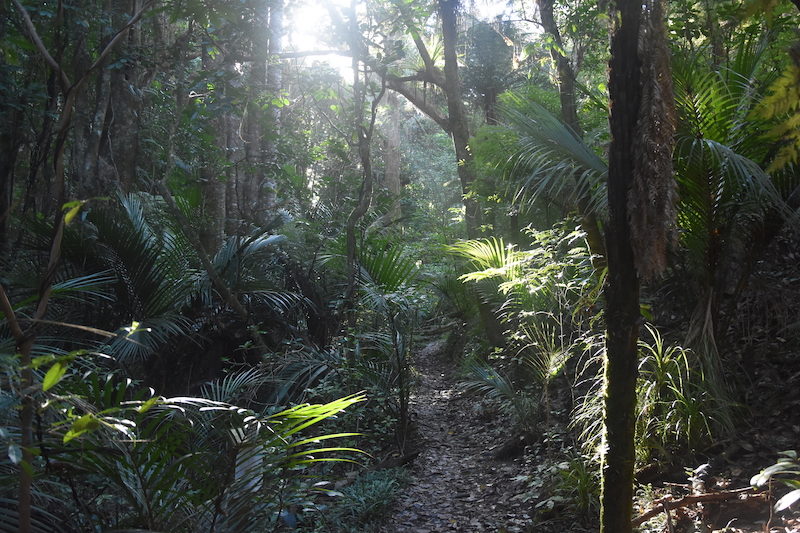
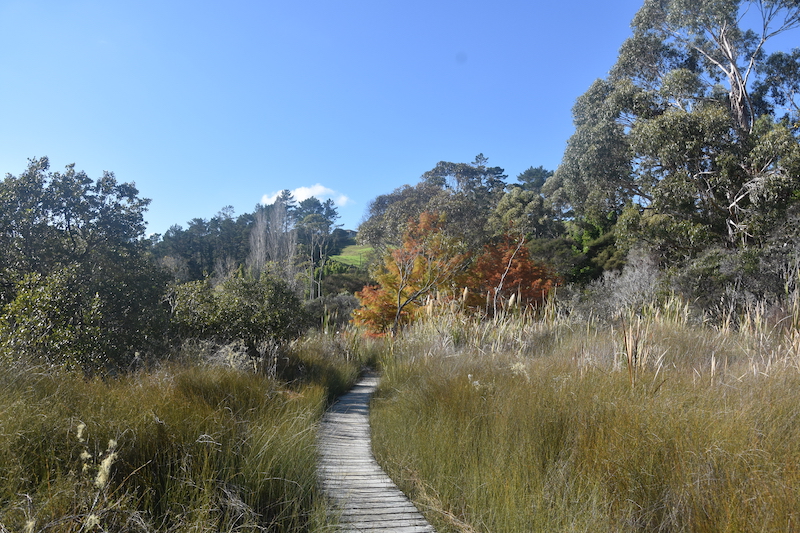

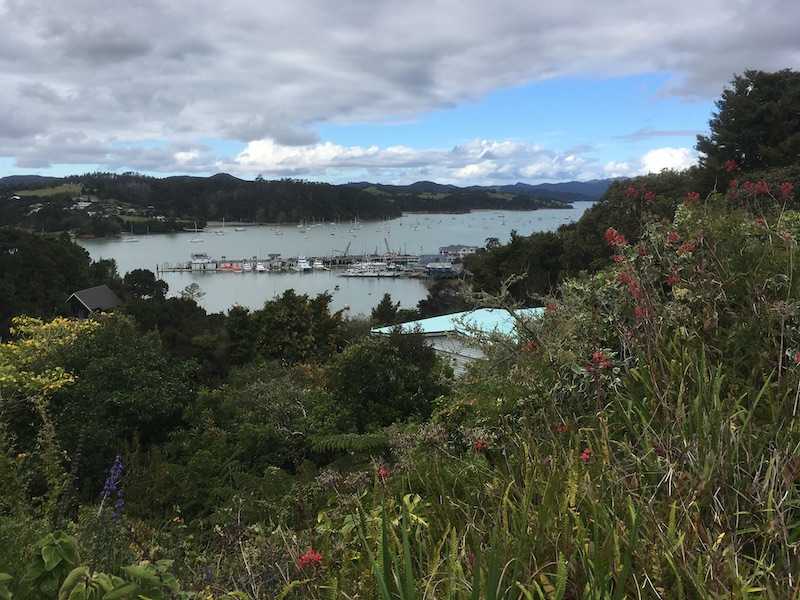
by chris ayres | Jun 2019 | UK to New Zealand
All ready to go it was a matter of waiting for a good weather window for the passage to Fiji.
Following the passage of a front with a bit of a blow, the forecast looked good. Time to go and indeed apart from a windless departure when I had to motor for 8 hours we had good winds.

At some some stage with our rate of progress I reckoned we would arrive in Fiji on a Fri eve or Sat morning. With the Fijian authorities charging overtime, minimum 3 hours at weekends at 100F$ per hour, a weekend arrival is to be avoided.
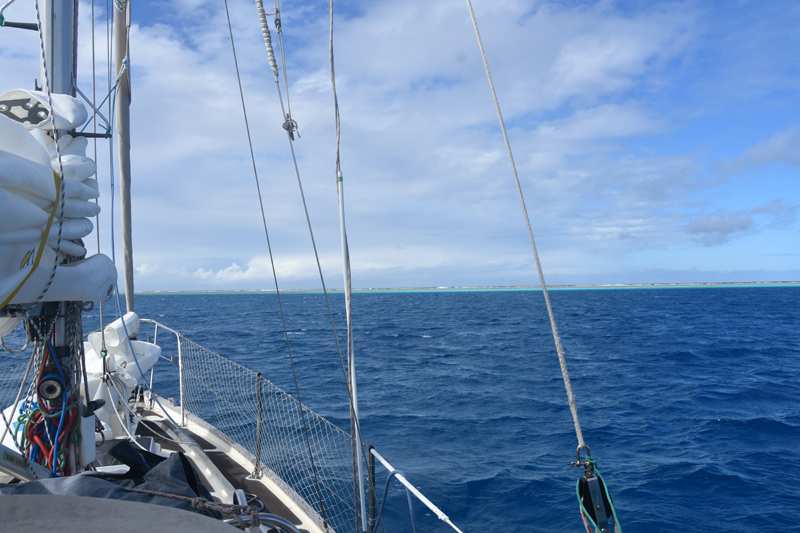
Anchored at Minerva reef
So although I had not planned to stop over at Minerva reef I now did thinking to stay just 2 nights. However I arrived with one of those squeezes between a tropical depression to the north and a high to the south. The wind soon picked up and didn’t slacken below 24 knots for 5 days. Anchoring here in these conditions was anything but restful. After 4 days I was fed up of the situation and headed out, leaving later risked another weekend arrival.
I did wonder the wisdom of my decision with 27 knot winds and gusting higher and rough short seas, but Vancouvers are such good sea boats, 3 reefs in the main and staysail she just ploughed on.
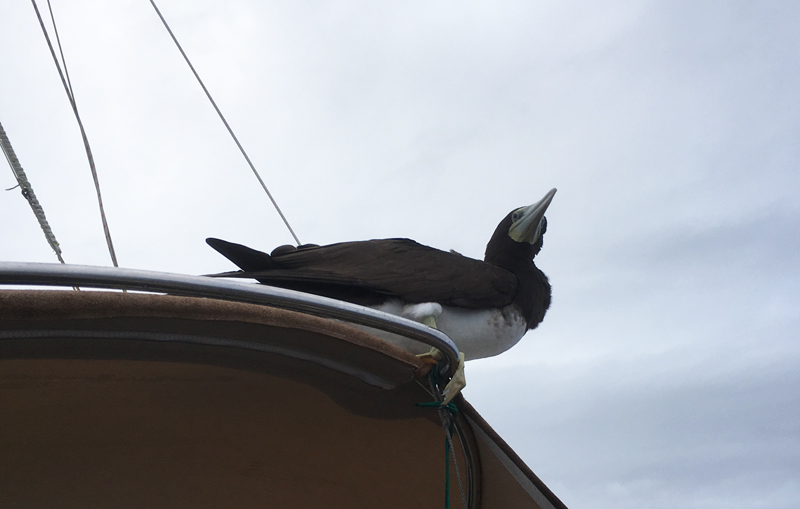
Booby aboard
Dawn of the 15th day since leaving Opua revealed the island of Matuku, the first of the Fiji group. I would have liked to stop here but you must check in at a recognised port of entry so had to keep going.

Matuku Island Fiji
Closing with my destination and it seemed likely that I would arrive on a Thursday eve just after dark. Not liking this idea I decided to slow down so as to arrive at first light Friday. Down to just a staysail though I was still going too fast, around 4 knots. Ironic how sometimes you struggle to achieve that speed with all sails set! Still once past Koro island with a decent amount of sea room all around I hove to for few hours. Letting draw later I arrived with good light to spot the pillar marking the reef of the point, rounding this, another few miles in the bay to arrive at Savusavu,
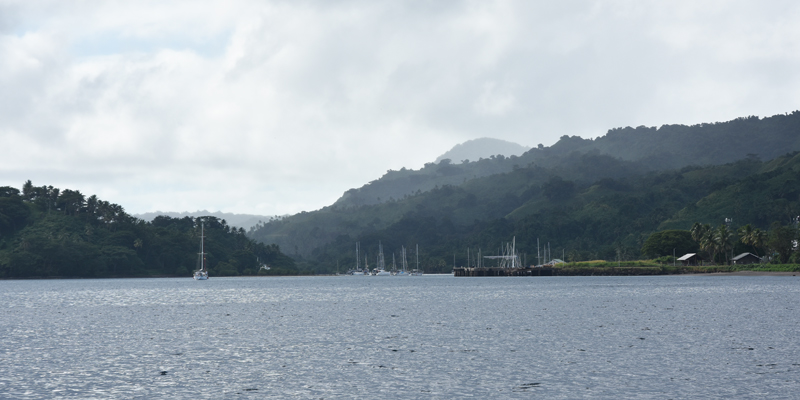
Approaching Savusavu
I picked up a mooring buoy at 09.30, perfect for normal working hours for the authorities.

Savusavu
Checking in was quick and painless, here they come out to your boat, Health pratique, Biosecurity, Customs and Immigration. Given permission to land it was time to find an ATM, pay the relevant fees and then the reward of a cold beer.
Passage of 1257 miles
by chris ayres | Jun 2019 | UK to New Zealand
It was good to recover and relax after the passage and do a little exploring around.
I walked out along the coast to the end, Passage point, visiting on the way the Flora Tropical gardens. I wandered around the timber walkways amongst many endangered palms, a tranquil and beautiful place.

Mangroves near Passage point
I also took a bus ride to Labasa, this took me along the coast, up into the mountains and the rainforest then down through pine forests and through vast areas of sugar cane.

Bus trip to Labasa
Labasa is a very Indian town with shops full of saris and curry houses. The Indians originally arrived as indentured labourers for the sugar plantations. Now it is reckoned they make up some 40% of Fijis population and their influence is plain to see.
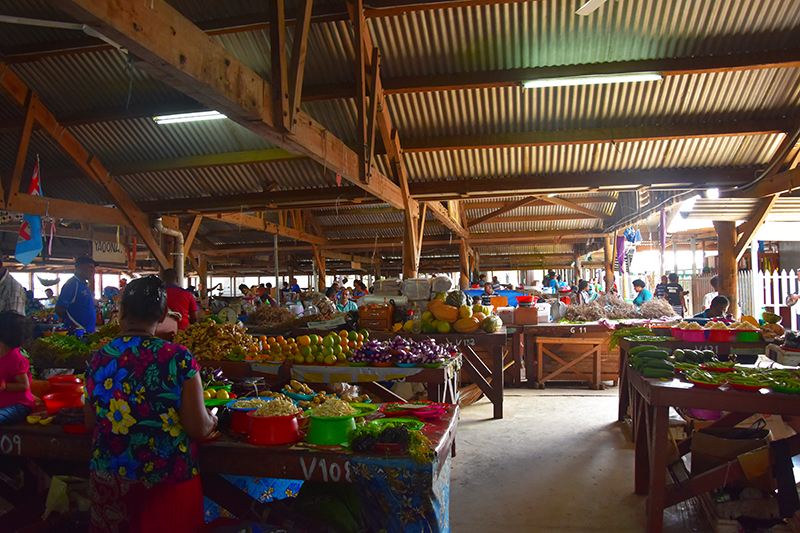
Labasa market

Taro
There is a good market in Labasa, I always delight to wander around markets see all the goods on offer and I bought some kava so that I may make sevusevu when I visit outlying villages.
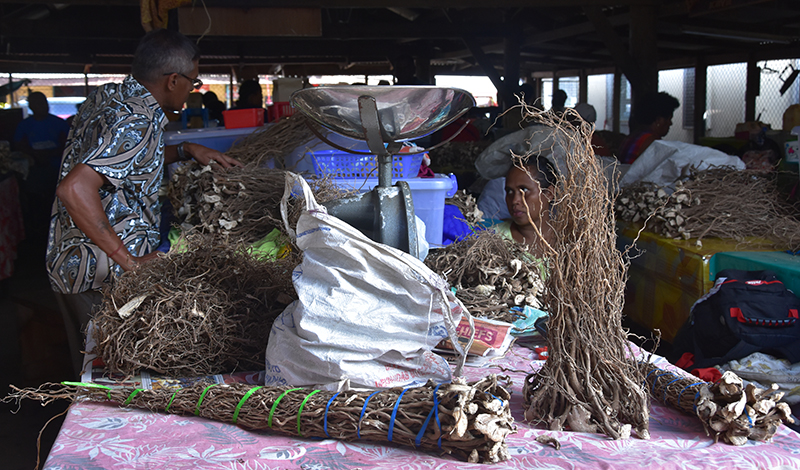
Kava

Buying Kava
I had a nice curry for lunch then later caught the bus back. This bus ride was great way to see other parts of the island.
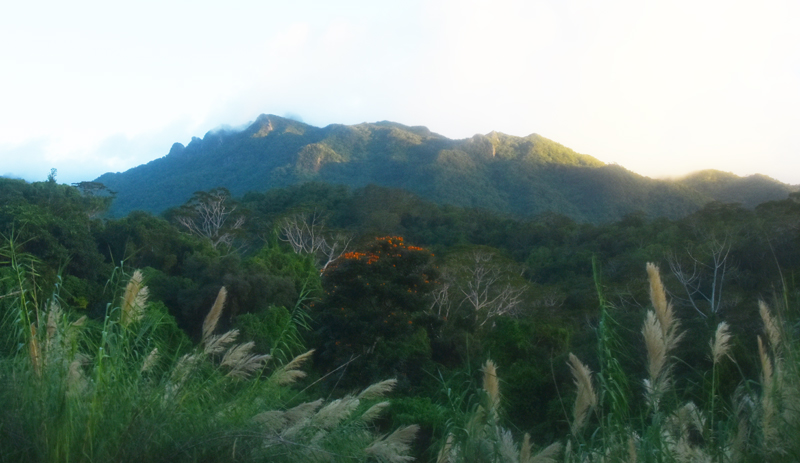
Fiji mountains
Another day I took the bus out to the Copra pressing plant where they extract coconut oil from the copra. Unfortunately they weren’t pressing oil that day so I could not see the whole process. Had a long hot walk back.

Coconut plants

Extracting copra
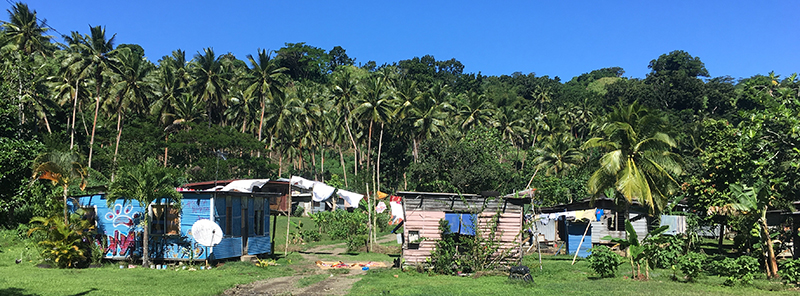
Fiji village
Meanwhile my friends Jan & Richard had arrived from New Zealand in Morpheus. They had had a rough and worrying passage and trouble with their engine so they arrived under tow.
The weather has been unsettled with lots of dark clouds and rain and strong winds so I am waiting for an improvement before heading off anywhere else. Because of all the extensive and largely unmarked reefs in Fiji, navigation is a bit of a challenge and you need good light and visibility so you can see the reefs underwater.
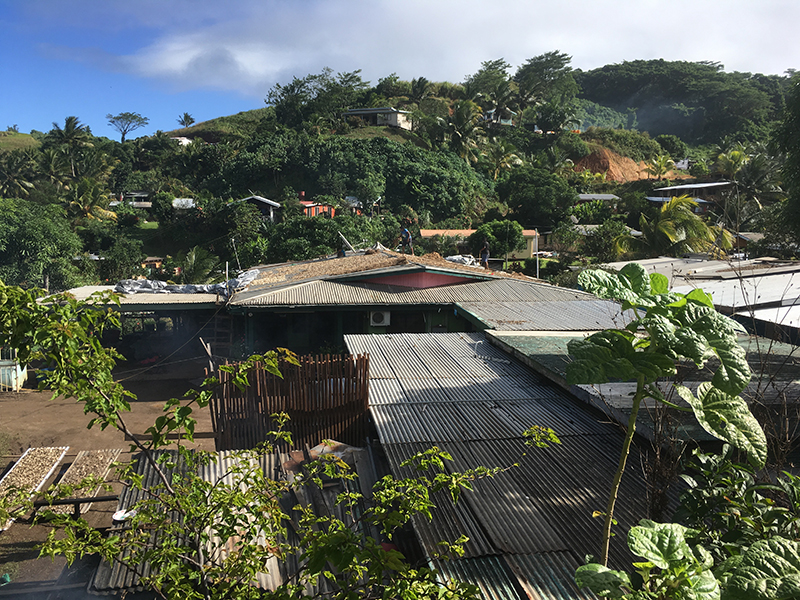
Kava drying on roof
Another walk took me over the hill behind the town and down to the south coast. The tide was out so the sea a long way from the beach over the reef, but I love these wanders looking at the house and villages.
by chris ayres | Jul 2019 | UK to New Zealand
At first I was the only yacht anchored off Vacaia Bay, Taveuni, but later more yachts joined me there including a family I had met in Katherine bay. They had caught a Mai mai that morning and like me and unusual these days had no fridge so they gave me some generous sized fillets. Good eating this. It was a beautiful spot here. I walked to the supermarket past the airstrip at the tip of the island for bread and stopped for a beer on the way back sitting on a lovely veranda overlooking the bay.

Vacaia bay
Ilil who I had briefly meet in NZ and then bumped into again, joined me for a couple of days as I said I would give her a lift to Qamea. Had a good sail around the north of Taveuni but just as we were about to go through the reefs to Qamea the cloud mist and rain came down. Fortunately it only lasted a little while. According to the charts the reefs were supposed to be marked with beacons but they were missing, probably wiped out by one of the cyclones. Anyway safely through we proceeded until we could safely turn into Naviivi bay. The reefs halfway in are at least marked and we could anchor beyond them. Two guys in a boat came out to talk to us, went away then returned shortly with a note from his Mum who was an Auntie of someone on Taveuni that Ilil had got to know. We were invited to visit so putting on my sulu and grabbing a bundle of kava we were ferried ashore in the school boat, made sevusevu with the headman of the village and then went to visit Angela and family.
There are no roads on this island and the children go to school by boat.
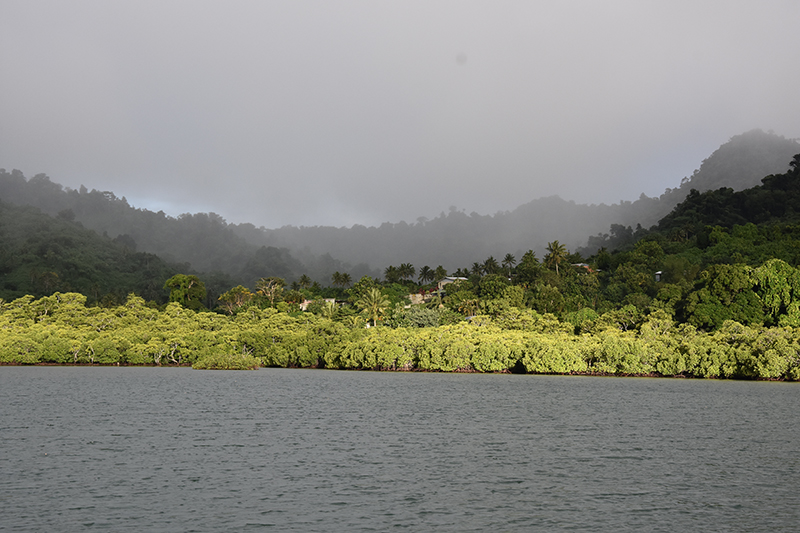
Naviivi Bay
Next day on the way for a walk towards another village we past a group of 7th day adventists who had just finished their morning service. They invited us to lunch with them and would brook no refusal. So we sat down in the shade of their church cum shelter crosslegged around some big straw matts with vast bowls of Fijian fare. Resuming our walk was up a steep narrow overgrown and very muddy track, plenty of slipping and sliding. I turned and and returned at the top of the hill.

Naviivi bay from on high
Ilil left to stay at another village and I set off for the long trip to the island of Nairai. The winds were light and sometimes non-existent for this 90 mile passage so it took me over 30 hours .
I anchored off the village of Tuvo Lailai in Green Mound bay. Next day I went ashore to make my sevusevu with the headman. This the main village on the island was very small and there are no roads or vehicles on the island at all. They live by farming and fishing.
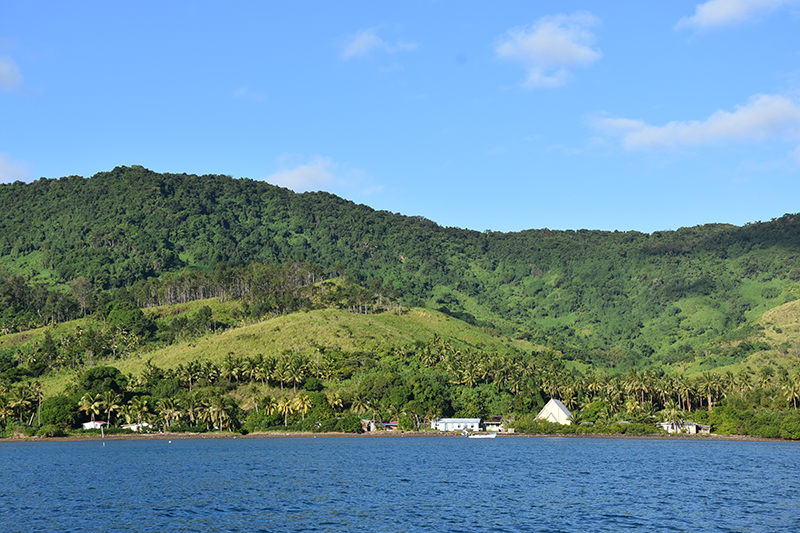
Green mound bay, Nairai
The day turned out rather miserable, completely overcast sky high winds and rain and kept that way all night and into the next morning. The anchor had dragged a little in the night so I wasn’t happy at this anchorage. Late morning the weather looked to be clearing a little so I took the opportunity to weigh anchor exit the reef and head over the the nearby island of Gau where after entering the reef at the middle passage I anchored in Heralds bay.
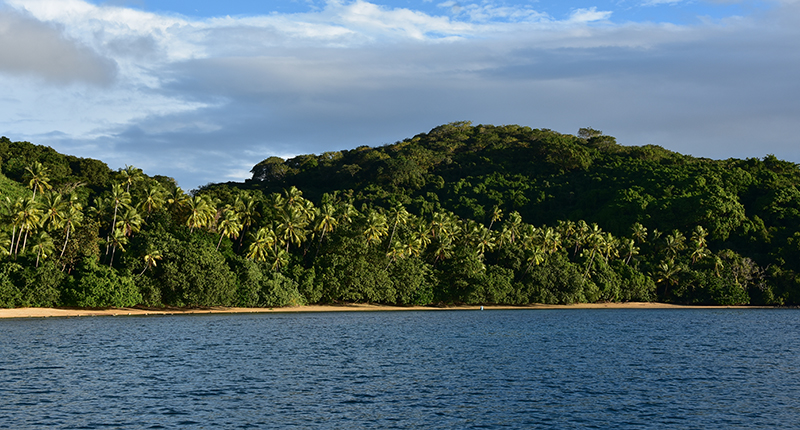
Herald bay, Gau
This might be some version of paradise, crystal clear waters yellow coral sand beaches, coconut palms and a steep hillside behind. I saw turtles and you didn’t need to snorkel to see the brightly coloured fish and soft corals – just row to the beach.
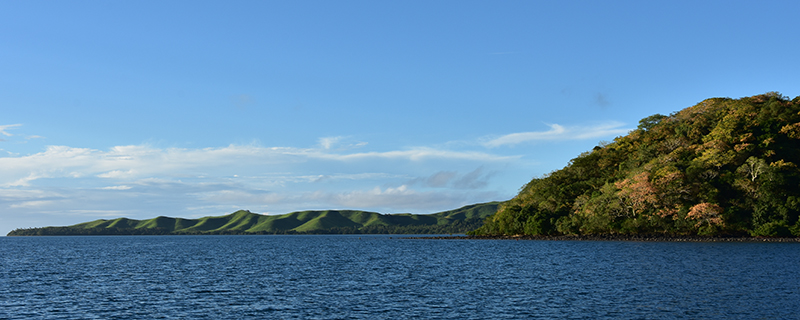
Coconut point, Gau from Herald bay
No-one lives in this bay though they visit it to fish or gather coconuts. The village of Sawayake lies in the next bay around the corner. Next morning I found the track that led there through the forest. Once again dressed in my sulu I made sevusevu with the headman and was welcomed to the village. The headman had lived in England a while, at Catterick camp when he was with the Royal Signal Corps.
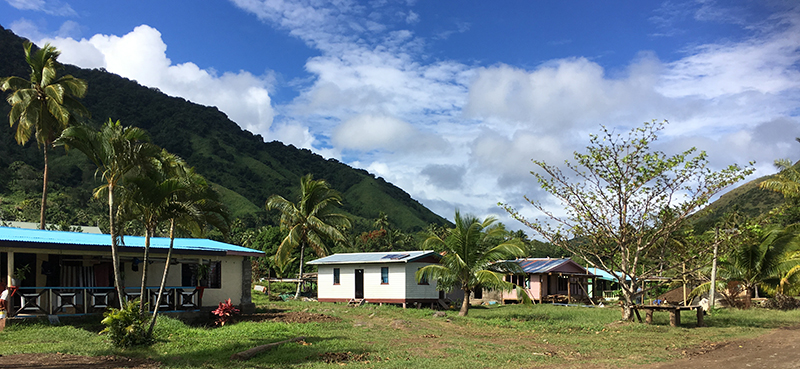
Sawayake village Gau
Wandering about I was invited in for tea and many people wanted to talk to me. Walking back I was thrilled to see my first Fiji parrot close up, brilliant red and green. Back on the beach with the dinghy was a man and two of his sons. We sat and chatted and they gave me green coconuts to drink, delicious and refreshing. Some women were fishing from their bamboo raft. It was a glorious day.
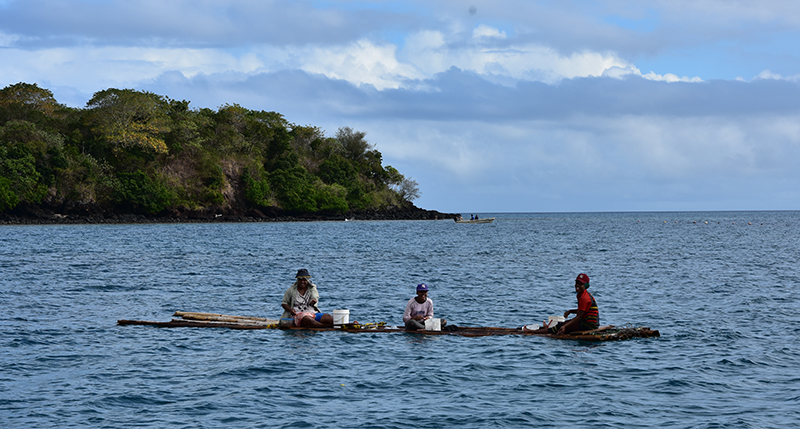
Fishing from bamboo raft
All change in the night, high winds and rain and from the S or SW so bringing some swell into the bay so the boat had swung through 180 degrees. It was unpleasant and slightly worrying. All next day overcast sky, wind and occasional rain.
Neither of these bad weather spells had showed up on the long range forecast, all these while it was supposed to be fine – so much for forecasts.
Next morning there was some breaks in the cloud and the wind had eased a little though still strong. I had had no bread for days and was right out of fresh vegetables being away from shops for so long and anyway it was time to head west so I weighed anchor and headed for Ovalua. I still had 20 -23 knots of wind at first and moderate to rough seas but with the wind on the beam, 2 reefs in the main , staysail and partly furled yankee Sea Bear made good speed. I thought the 30 mile passage might take 7 hours or more but within 6 we were in through the reef at Levuka and safely at anchor.

Levuka, Ovalau
by chris ayres | Jul 2019 | UK to New Zealand
Eventually the forecast was looking better and I left Savusavu. First hop was just about 5 miles down the coast to anchor by the reef just past Costeaus resort.

Anchorage at Cousteus
It meant the saving of about an hour on the next day a day to round passage point and head east along the coast. It meant motoring most of the day but I did a couple of hours sailing in the middle of the day before the wind died. The entrance through the reef to Fawn harbour had a dog leg but visibility was good and safely inside I crossed the lagoon to anchor. A very peaceful tranquil place this, just the distant roar of surf on the reef. I stayed the next day having a peaceful but lonely birthday.

Fawn Harbour
Leaving through the tricky entrance then east again, a flat calm so more motoring. I headed for the reef entrance of Vivani then carried on around the SE tip of Vanu Levu and up to the narrow mangrove lined bay of Naqaiqai. The wind was back but anchoring in 6m the holding in mud was good and the water sheltered. Next day was blowing hard so I remained here.
Next place to visit was Bucca bay, passing Kioa island where they were out fishing from their outrigger canoes. It was calm when I got to Bucca but no sooner having dropped the hook the wind sprang up blowing from the NE. The bay is open to this direction so a chop soon built up. Nevertheless I did go ashore for a walk. I thought that since there was a wharf that a ferry went from served by a bus from Savusavu there might be a shop, I could do with fresh bread but there was none. I did get some pink bananas though and some nice ginger.
It wasn’t really on to stay overnight on account of the wind and chop so I ups anchor, retrace my track to Kioa island. Entering the bay by the village I thought better of anchoring here, I couldn’t find anywhere suitable shallower than 20 m and the bay wasn’t sheltered in the prevailing conditions. I nipped back across to Naqaiqai. I would have liked to visit Kioa, the inhabitants are from Tuvalu, 800 miles to the north, displayed to here when their own island was threatened by sea level rise from Global warming.

Somosomo
I crossed the Somosomo strait to anchor of Somosomo on the island of Taveuni. A couple of the world ARC boats were anchored here. The anchorage doesn’t have a lot to recommend it apart from giving easy access to the shops. I bought a new sim card for the phone, had a chicken curry and bought fresh vegetables and bread.
The weather forecast was for a trough to arrive bring strong winds rough seas and much rain. Time to seek some shelter, the best prospect seemed to be Katherine bay on Rabi island. I had a bit of a rough passage back across the strait, winds gusting to 27 knots and breaking seas. The fringing reef of Rabi is about 4 miles offshore, the passage in not marked so some tension. Once inside the reef I had hoped the reef would break the waves and calm the seas but the reef is not shallow enough so it was rough all the way in finding a careful way between the inner reefs. Once inside the bay although the wind was till strong the seas were much calmer and I anchored in 9 m much relieved to be in.
Rabi although part of Fiji is populated by Banaban Islanders from the Gilbert Islands (now Kiribati). Their island was made uninhabitable by the extraction of phosphate a tragic and heartbreaking story caused by corporate greed and British government connivance.
You are supposed to report to the Rabi police here so according I took the morning bus, a 4wheel drive truck with bench seats, to Nuku the capital. There is just the one road on Rabi, well a dirt track really that runs through the jungle and along the coast. Nuku is not much of a capital, a village with just a few official buildings. None of the official building were occupied but enquiries pointed me to the policeman’s house- it was the one with the police bike outside. One oh his sons raised him from a nap and I presented him my papers and he made a few notes in a note book. It hardly seemed worth the effort. It was now about 11 in the morning, the next truck back I was told was not until 3. There was nothing to do in Nuku, so I decided to set off walking.

Road on Rabi
It’s always a nice way to see more of a place. Past a few small villages where the kids always waved and the adults greeted me with Mauri, the traditional greeting. I was the only white face around. The people are different from Fijians much more like Indonesians I thought.
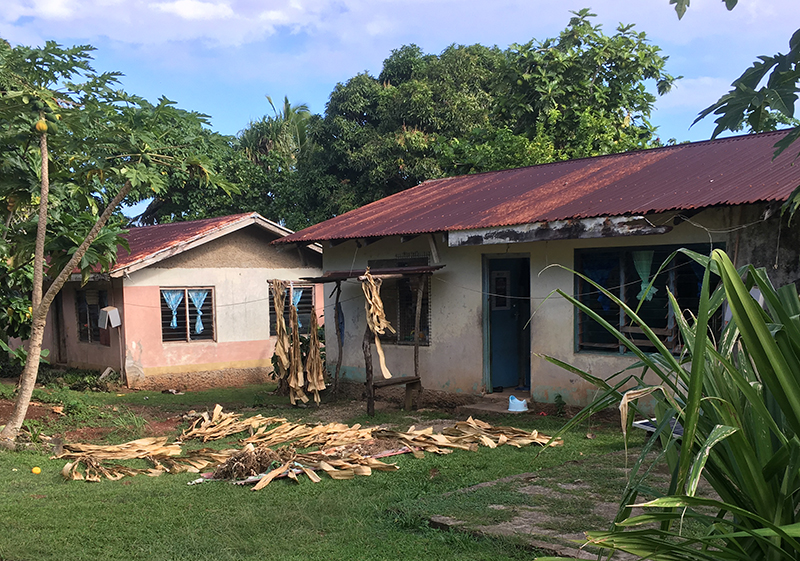
Drying palm fronds Rabi
I ended up walking all the way back, took me over 4 hours the last hour in heavy rain. Not one piece of traffic passed me in all that time. Passing by a house in the last hour as the rain came down I was called over to the veranda where gathered about 8 or 9 menfolk. A big bowl of grog (kava) was being passed around so I was pressed to partake, there is a fairly strict equiquette to this the cup is handed to you by the person on your left, you are supposed to drain the cup in one whereupon everyone gives 3 soft cupped hand claps. The elder here said he must sing for me so he sang and performed a meke dance partly in English partly in Kiribarti. He said there must be 3 songs and 3 bowls of grog. It was entertaining and enjoyable. Then I resumed my trudge back in the rain to the dinghy and so to the boat. Back aboard I stripped off in the cockpit so as not to take the wetness into the cabin.
The bad weather had certainly arrived but the anchorage was snug and secure.

Katherines bay
Some days later I moved around to Albert cove towards the north of the island. Getting in here was a double reef entry, first an outer reef then an inner reef to gain entry to the cove itself. All reefs unmarked of course, I was glad the light was good enabling you to spot the shallow water, even so it is a bit nerve wracking.
The cove was a lovely spot, yellow sand beaches backed by coconut palms. Only a couple of people live here to harvest the copra, there is no road or track access, just by boat.
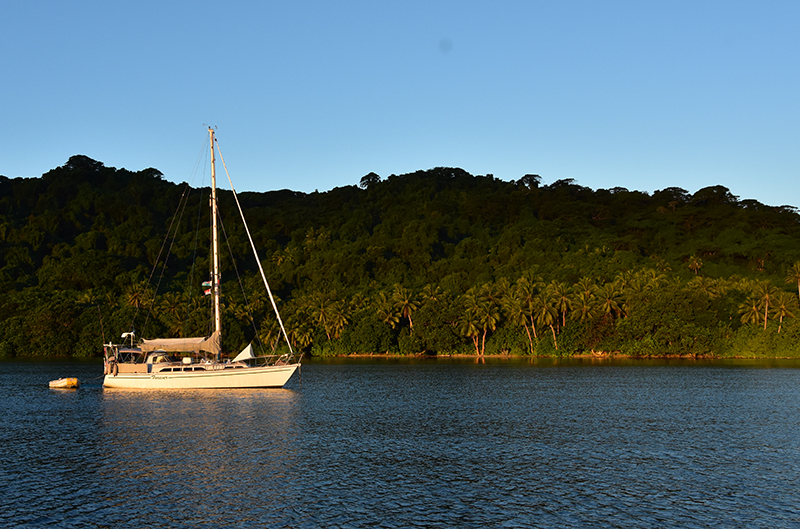
Albert Cove

Net fishing Albert Cove
After a while here I decide to go back to Somosomo, I was long out of bread and fresh veg. Good light is needed to get out of the cove so an early start is ruled out, the sun needs to be well up in the sky to see the reefs clearly. It limits your sailing time to say between 8.30/9.00 am until 4 pm
I didn’t have enough time to make it in one hop so stopped again in Katherine bay.

Katherine bay looking towards Taveuni
Back in Somosomo I was disappointed – there was no bread. Apparently no flour on the island because the ferry to the island from Suva had stopped running. I didn’t get the full story whether this is temporary or full time.
The anchorage at Somosomo is I find too rolly for comfort so I moved about 6 miles to the north of the island. Matai was recommended in through the reefs with flat water but the light was poor when I arrived and I didn’t like the look of it so went back half a mile to another anchorage off a beach.
by chris ayres | Aug 2019 | UK to New Zealand
Levuka was situated in a beautiful setting, a backing of a high amphitheatre of jungle covered hillside with rocky peaks. It was the original capital of Fiji and was were the secession to England was signed. The capital was transferred to Suva later when limits of space made themselves felt here.
Nowadays it feels like a slightly down at heel township although the Tuna cannery seems to be doing well, there is slight smell of canned fish permeating the town. It was a bit strange to be back in a place with roads, cars shops and resteraunts after my time on the islands.
I walked south down the coast to the place of secession marked by a bronze plaque and the original treaty house, now looking sadly neglected with vast patches of the thatched roof missing. Inland I climbed up the 199 steps of mission hill and carried on up the valley to a small waterfall where the towns water supply comes from. There were nice views over the town from here and many little shacks where everything had to be carried up by back.

Levuka – view from mission hill steps

Sea Bear at anchor at Levuka
After a few days I decided to make the trip to Suva. It was too far to go in daylight hours so late afternoon saw me weigh anchor and sail out through the reef entrance for an overnight passage. The wind was very variable mainly S/SE so to go S meant a lot of tacking. One tack to stand out eastwards from the coast and then a long tack S/SW almost going in the desired direction, gradually closing the coast until a mile away from the reefs then tacking out again. It was a wearisome business but eventually the lie off the coast turned around the corner so to speak and I could lay the desired course. Gradually I could go from hard on the wind to a beam reach then a broad reach and finally a run as I rounded the reefs off the SE corner of the mainland.
Eventually I came into line with the leading marks for passing the reefs to enter Suva harbour and could gybe to sail in. As befits a major harbour used by big ships, the beacons marking the reef edges and the leading marks were good, Once in I made my way across and anchored off the Royal Suva yacht Club by early afternoon. Only 75 miles but it had taken me 22 hours.

Sunset at Suva
Next day I walked into town. Suva is big and bustling and there are a number of department stores where apart from the cliental you could think yourself back in the UK, such a stark contrast to the islands. I shopped at the excellent fruit and veg market, had a nice curry for lunch and caught the bus back to the RSYC.
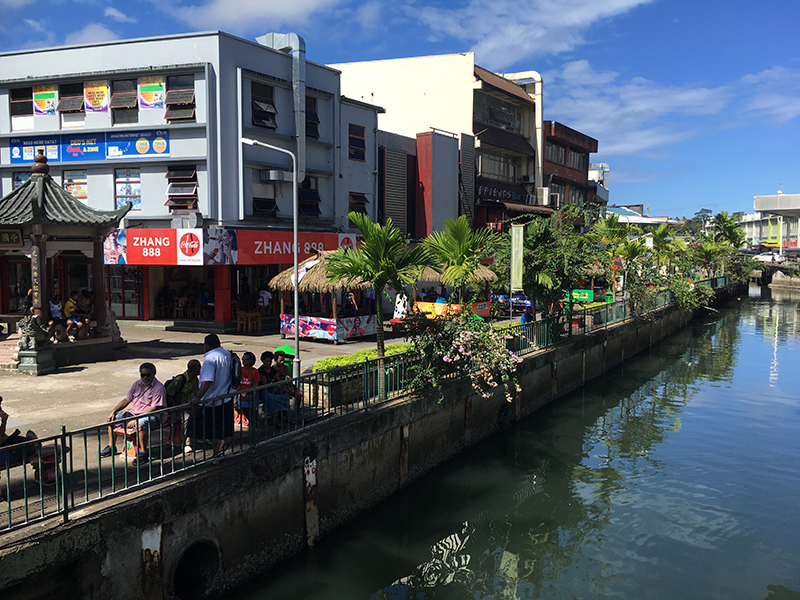
Chinese quarter Suva
We had another trough come through when I was anchored here, high winds, plenty of rain and a choppy sea which confined me to the boat for 24 hours.
Another day in town saw a visit to the botanical gardens, which I found a little disapointing.

Misty day Suva
Much better next day I took a bus out to Colo-i-Suva rainforest reserve. Had a nice walk around here, there were some nice waterfalls and pools including one with a tarzan type rope swing.

pool in rainforest

Rope swing
The path I took out was steep ‘rooty’ and muddy. Heard lots of birds but they are very hard to spot amongst all the trees.
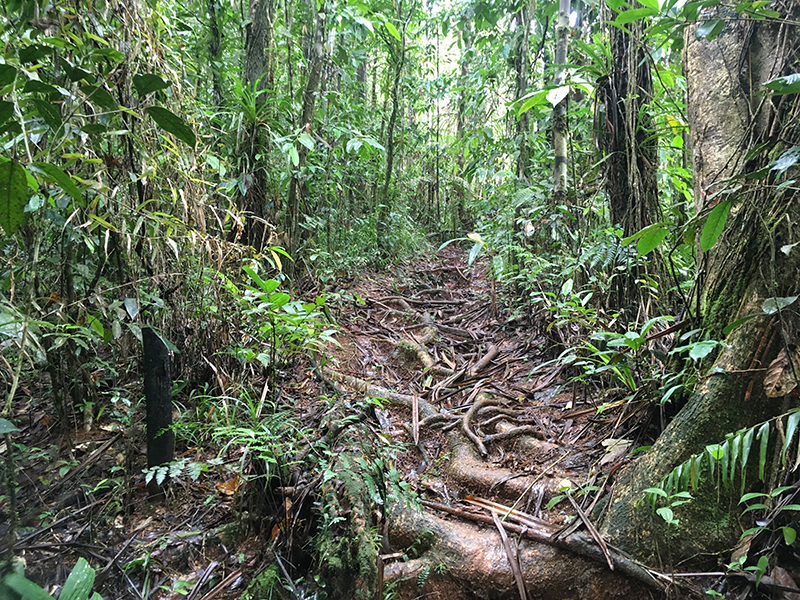
Rain Forest track
After several days I felt it time to leave the harbour is busy full of ships, many rustbuckets and wrecks and the water is dirty and polluted. I weighed anchor and headed out one morning, next stop 100 miles along the coral coast.

Suva harbour

















































